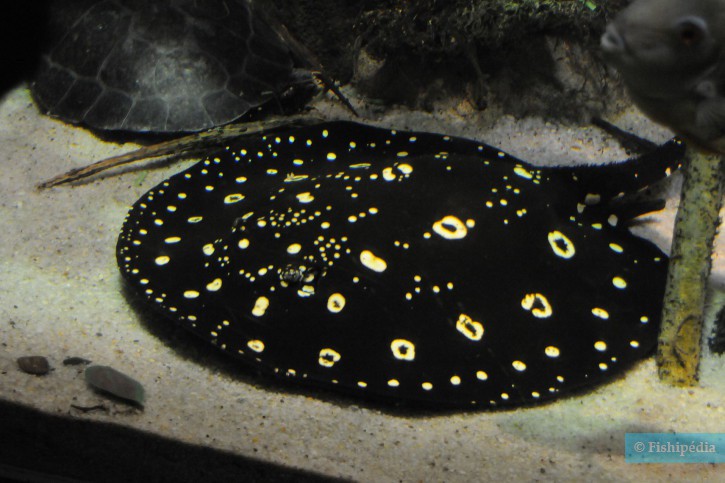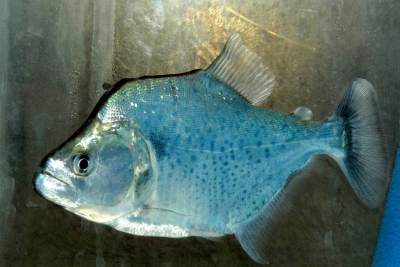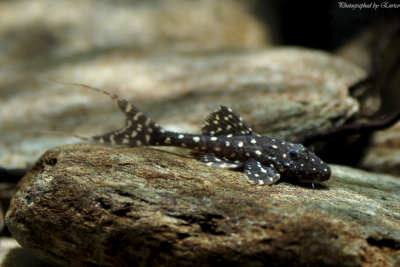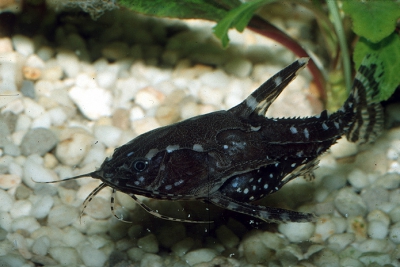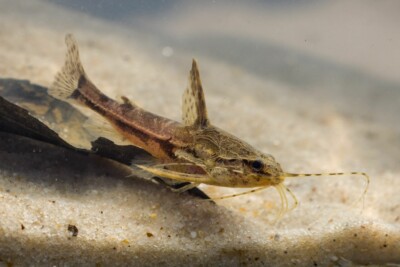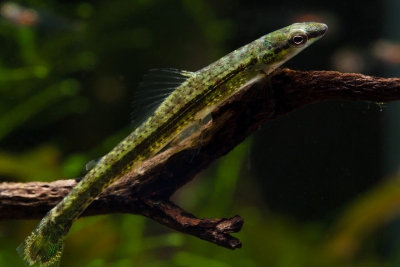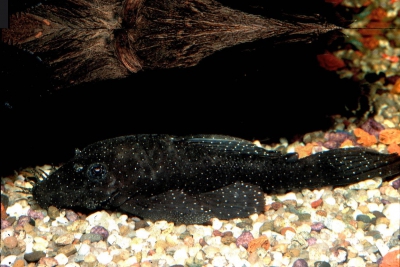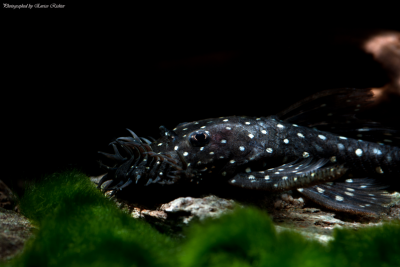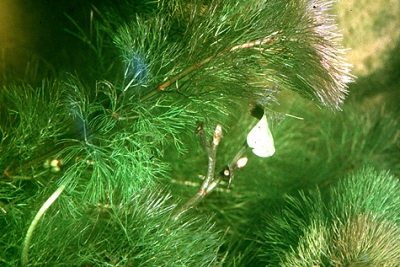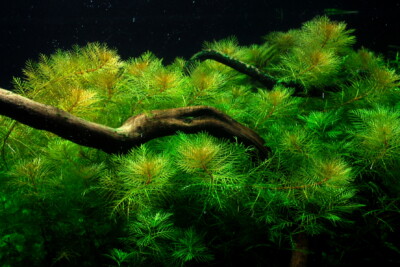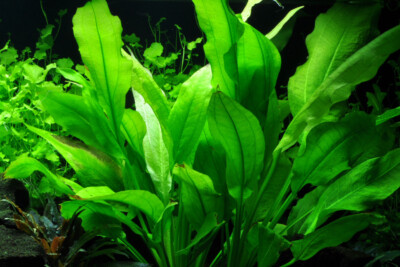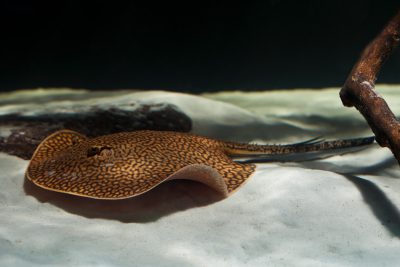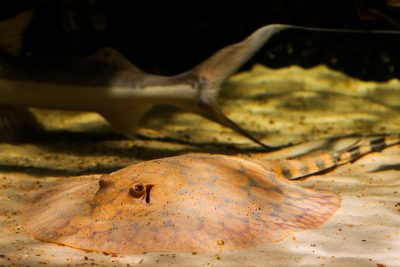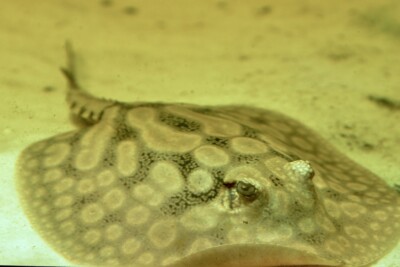bigtooth river stingray
| Scientific name | Potamotrygon henlei |
|---|---|
| Descriptor | Castelnau |
| Year of description | 1855 |
| IUCN category (World) | LC |
| Family | Potamotrygonidae |
| Genus | Potamotrygon |
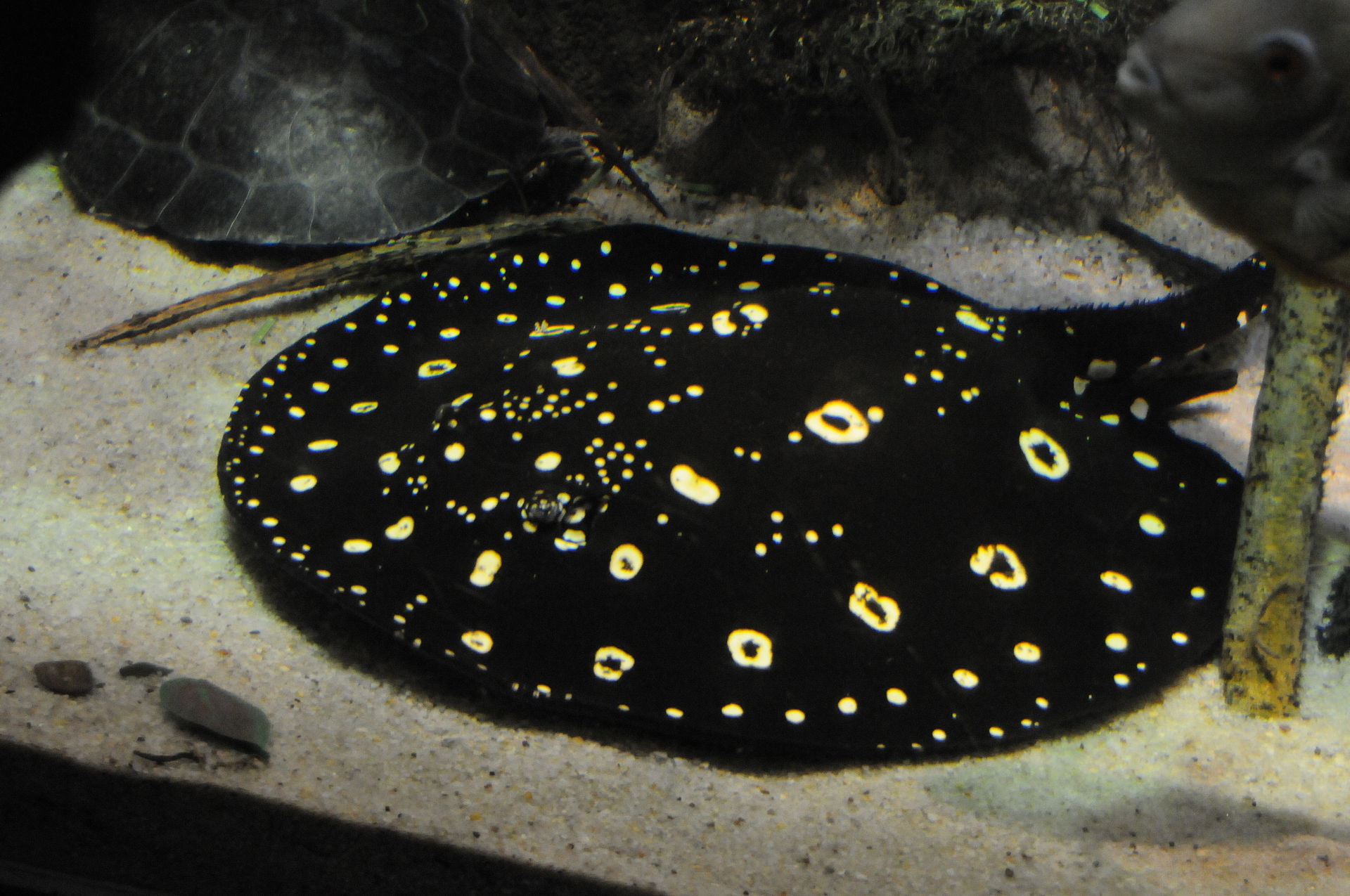

Introduction
Potamotrygon henlei, commonly known as the Bigtooth River Stingray, is a tropical fish native to South America.
Who is it?
Morphology
-
Type
-
Average size40 cm
-
Maximum size70 cm
-
Longevity12 year
-
ShapeCircular
-
Type
-
Average size40 cm
-
Maximum size70 cm
-
Longevity12 year
-
ShapeCircular
How to recognize This fish ?
Potamotrygon henlei is distinguished from Potamotrygon leopoldi by slightly smaller size, grayer coloration in juveniles, and yellowish spots. Henlei individuals have their "black with white dots" coloration extending onto the underside, around the edge of the disc, whereas in P. leopoldi, the underside is devoid of coloration.
However, this distinction is relative, as the two species hybridize very well, even generating intermediate individuals in nature.
Sexual dimorphism
The male is equipped with a pair of reproductive organs called pterygopods. They result from the mutation of the pelvic fins into two mobile tubes that allow internal fertilization. This dimorphism is visible from the birth of the juveniles.
Both sexes are equipped with one or more stingers on the last third of the tail. The oldest stinger falls every 4 to 5 months, pushed out by the new one that will replace it, as the animal grows.
The females are devoid of pterygopods, but also much larger than the males. A female can easily reach 70 cm disc width. A male will reach a maximum of about 50 cm.
Behaviour & Life cycle
-
dietcarnivorous
-
Sociabilitysolitary
-
territorialNo
-
Way of livingdiurnal
The Henlei Stingray is a fish that lives in an extended colony, with individuals coexisting but needing individual space. It naturally resides on the bottom but swims very well in midwater.
It is not uncommon to find traces of its nocturnal parking spot on the sandy banks in the morning. Each individual leaves a circular depression in the sand.
It is a fish that mainly lives at night, leaving its hiding spot once dusk arrives.
Of a rather calm temperament, this species regularly blends into the surroundings, waiting for potential prey. To do so, it covers itself with sand and remains immobile for long periods.
However, beware, the "black with white dots" rays from the southern tributaries of the Amazon are considered robust and easy to care for, but also among the most lively of the kind.
Reproduction
The Bigtooth River Stingray is an internally oviparous fish.
Risks for humans
-
VenomousYes
This species is venomous and can cause serious injuries when touched.
What to do in the event of a sting?
in case of sting, the following rules should be followed, in this order:
- Isolate the victim from the danger and quickly remove him or her from the water
- Call for help
- Lay the victim down in a half-sitting position and avoid any effort
- Immobilize the affected limb
- Clean the wound
- The venom of this species being thermolabile, it can be neutralized if it is submitted to a temperature of about 45 °C. It is therefore possible to heat the wound. This popular technique should be practiced with great care so as not to aggravate the wound by burning it. It is advisable to immerse the affected limb in hot water.
- If the puncture is too deep, heating the wound will be less effective.
Sometimes the sting can cause discomfort or even loss of consciousness in the victim. The stings are usually very painful.
Origin and distribution
Conservation status of populations (IUCN)
What is its habitat?
Natural environment characteristics
-
Temperature23 - 28 °C
-
pH (acidity)5.8 - 7.2
-
gh (hardness)2 - 10
-
FlowMedium and Slow
Biotope presentation
The Henlei Stingray naturally resides in the main beds of clear water rivers, particularly the southern tributaries of the Amazon, especially the Tocantins. These rivers have very large seasonal variations not only in water level but also in physico-chemical parameters, to which the rays adapt perfectly.
It is erroneous to limit its habitat to a single biotope, as the ray moves between its diurnal and nocturnal modes, and does not occupy the same sectors of the river.
Species of the same biotope
Main recommendations for fishkeeping
Deontology
In order to preserve wildlife, if you acquire this animal, it must not be released into the wild. See also, the Fishipedia charter.
Fishipedia supports the practice of responsible and environmentally friendly aquarium keeping. We encourage maintenance if it is motivated by a desire to understand the biological functioning of living things and if it is done with respect for animal life.
We believe that aquaristics is an opening to the discovery of aquatic environments, especially freshwater, and that this knowledge is necessary to better protect and respect these environments. Logically, we refute the compulsive purchase of animals that would not find a sufficient and / or adapted place in the host aquarium.
Our recommendationsThese tips apply to adult species from breeding. With regards to water conditions, wild species or close relatives must be kept under the same conditions as in their area of origin.
-
Min volume3000 liters
-
Population min1
-
Temperature23 - 28 °C
-
pH (acidity)5.8 - 7.2
CharacteristicsThe characteristics below apply for adult species. They correspond to an average of cases, validated in maintenance condition.
-
Difficulty breedingThe farming difficulty is relative. It depends on experiments already carried out with similar species. First, it takes into consideration the robustness of the species, the ease of recreation of a favorable environment and the general behaviour with the other inhabitants of the aquarium.moderate
-
Robustnesstolerant
-
Behaviourpeaceful
General reminders
It is strongly advised to read the complete dedicated file and to get information on the feedbacks of maintenance of the envisaged animal, this to avoid any potential conflict whose end result is generally the death of the individual (or the other inhabitants). It is important not to overload your aquarium to limit pollution. This will make maintenance easier.
In nature, animals are subject to weather conditions and live in waters with variable characteristics. The recommendations offered by our team for aquarium maintenance are a guidance and cannot be assimilated to scientific datas.
Beware, as this species is potentially dangerous to humans, it requires for its maintenance the obtaining of a "certificate of capacity of breeding". For professionals, it is necessary to have a "certificate of presentation to the public".
General reminder on maintenance datas
Le démarrage d'un aquarium est une partie primordiale pour l'équilibre et le bien-être des poissons. Lorsque l'on met en eau un aquarium, l'eau passe naturellement par un cycle biologique : le cycle de l'azote. Celui-ci dure environ trois semaines. Tous les 2 jours, nous vous conseillons de tester votre eau jusqu'à ce que le taux de nitrite soit à zéro pendant plusieurs jours d'affilée.
Pour accélérer ce cycle, vous pouvez utiliser un activateur de bactéries comme JBL Denitrol. Cette solution riche en bactéries vivantes et enzymes permet une mise en place rapide du cycle de l'azote. Les poissons peuvent alors être introduits plus rapidement.
Il est important de tester l'eau de son aquarium régulièrement pour maintenir un environnement sain pour les poissons et les autres habitants. Les tests d'eau permettent de mesurer les niveaux de différents paramètres tels que le pH, la dureté totale, ainsi que les taux de nitrates, de nitrites et d'ammoniaque.
Pour réaliser ces tests, vous pouvez utiliser des produits d'analyse spécialisés tels que JBL ProScan qui permet de réaliser un diagnostic de l'eau directement via un smartphone. Il existe également des coffrets de tests plus classiques de bandelettes, comme JBL PROAQUATEST.
En cas d’usage de l’eau du robinet, vous pouvez utiliser un conditionneur d’eau de type Biotopol de JBL pour éliminer les substances nocives comme le chlore, le cuivre, le plomb et le zinc. Les conditionneurs d'eau garantissent une meilleure santé aux poissons et une meilleure croissance des plantes.
Chlorine and chloramine are dangerous for the health of animals. Used to disinfect water, these agents are present in significant quantities in tap water. We recommend using an anti-chlorine agent every time you change the water. In addition to chlorine, treatments and medicines sold for aquarium use sometimes contain dangerous heavy metals in high doses.
Specific needs for the bigtooth river stingray
The bigtooth river stingray is a species which lives naturally at a temperature between 23 °C and 28 °C. For proper maintenance, the temperature should never exceed the 31°C for long periods. Nitrate levels should remain below 50mg/L. To keep the water clean and unpolluted, plan on changing 20% to 30% of the water volume each month.
The breeding of this species is accessible on condition of being well informed about its needs in aquarium . Any cohabitants must be chosen with care to avoid the loss of animals.
Cohabitation & Environment
This fish being a predatory species, it is recommended to maintain it in a specific environment, without other species. Indeed, any crustacean or fish of lower size will become a potential prey. A 3000 liter aquarium with at least 300 cm of frontage is the minimum recommended for its maintenance. If you still try to associate it with other species, the cohabitants must be of a size at least comparable to the predator in a much larger volume. The aquarium can be provided with many hiding places and a large space to allow each individual to find refuge if necessary.
Tips for feeding
The bigtooth river stingray is carnivorous.
You should not overfeed your residents to avoid polluting the water. For most species, it is better to feed a few small portions each day rather than one large meal.
Reproduction protocol
-
egg-laying protectionNo
Hybridization risks
In general, it is advised not to mix several species of the same genus or different varieties of the same species, to avoid the risks of hybridization.
These animals might interest you
These plants might interest you
Plants play a crucial role in aquariums, both for their ability to filter water by absorbing excess nutrients and for their aesthetic contribution. They provide fish with natural hiding places, can serve as breeding sites, and generally help maintain the overall balance and optimal conditions of the aquarium. The selection presented here includes species from the same regions as the species described on this page, although they do not necessarily come from its exact natural biotope.
To go further
Sources & Contributions
Participation & Validation
The Fishipedia team and specialist contributors are committed to providing high-quality content. However, although the information comes from scientific sources or testimonials from specialists, the cards may contain inaccuracies.

Robert Allgayer

Christophe Girardet

Benoit Chartrer
Translation
Translation done with the valuable contribution of our translators, who make this information available to a wider audience. We sincerely thank them for their commitment.
In collaboration with : Fédération Française Aquariophilie
Scientific partners
Same genus
Species of the same biotope
